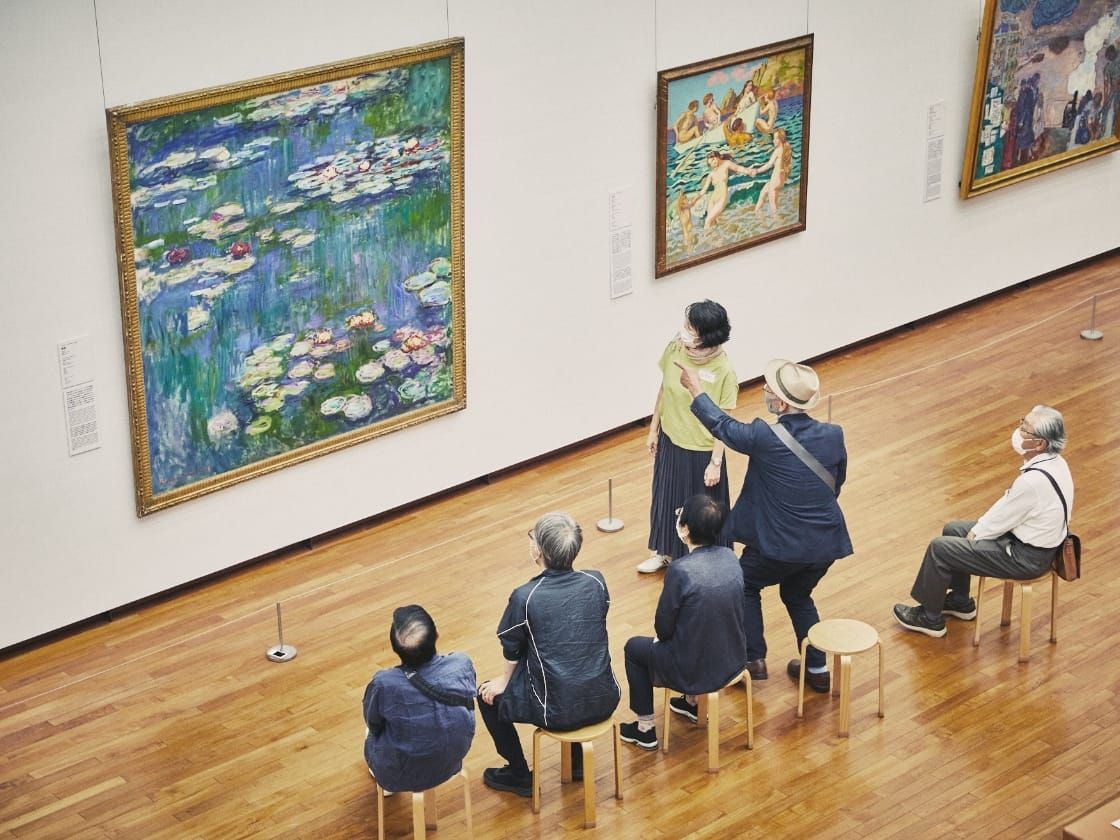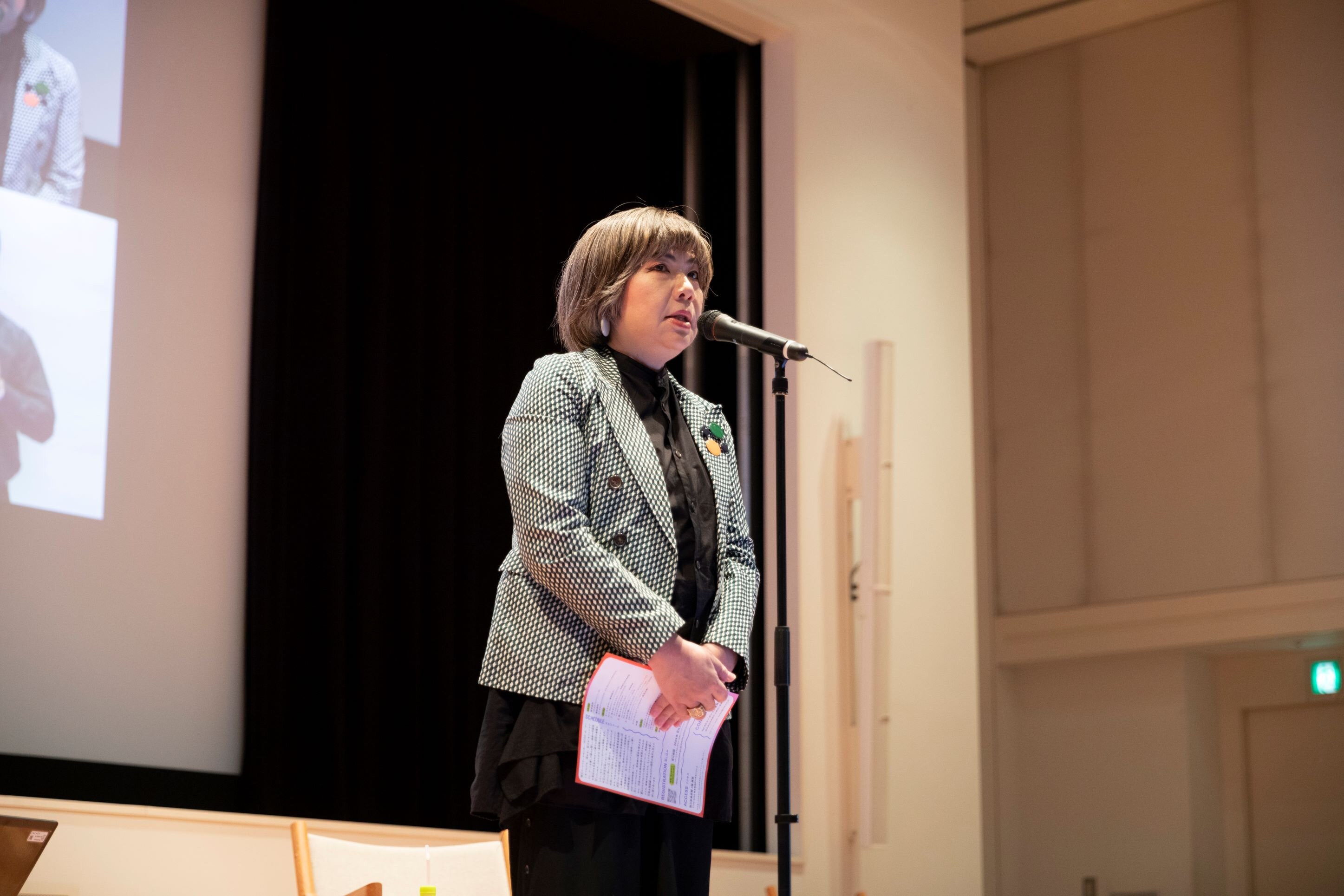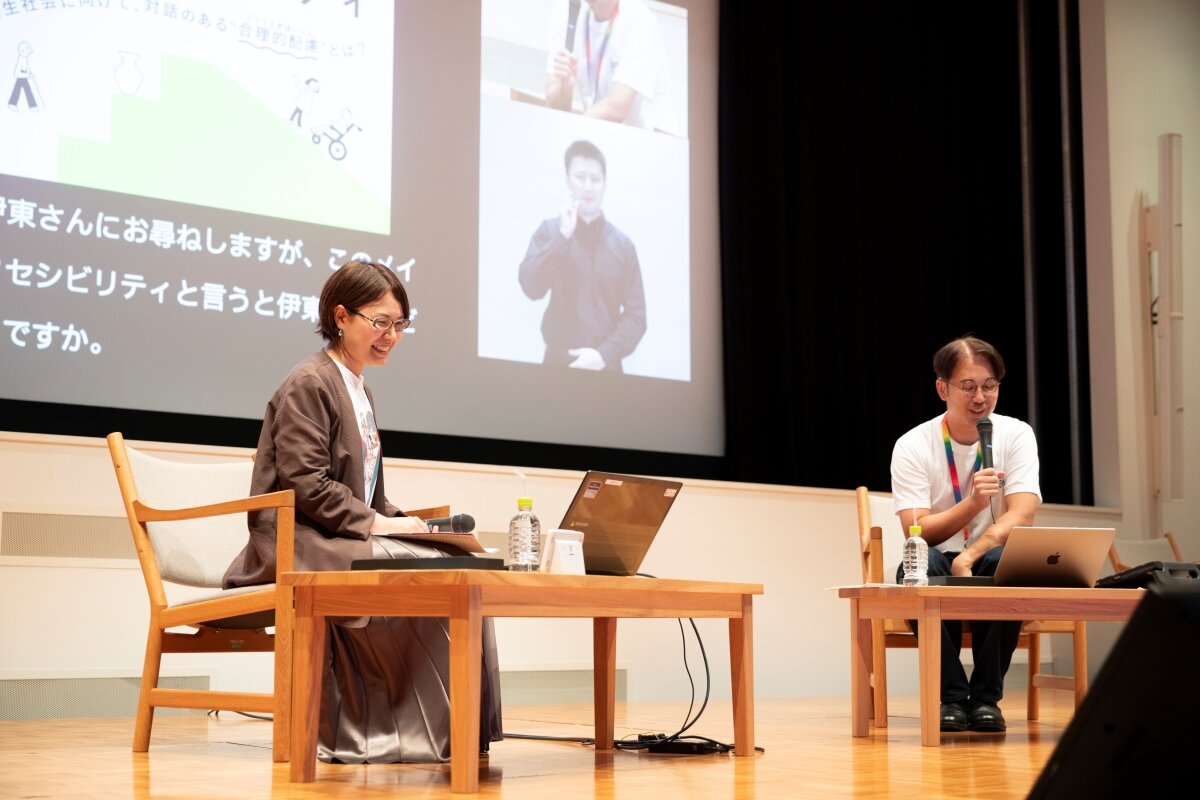[Symposium Report] NCAR Symposium 003: Accessibility in Museums—What Does "Reasonable Accommodation" Mean in an Inclusive Society? (Held on September 23, 2024)
Author: Sawako Fukai (SW_)
![[Symposium Report] NCAR Symposium 003: Accessibility in Museums—What Does](/en/upload/IMG_7227_s.jpg)
Back row, from left: Katsuhiko Hibino, Chikako Suzuki, Sawako Inaniwa, Shunsuke Ito, Mami Kataoka, Eise Shiraki
Front row, from left: Saki Matsuyama, Takayuki Mitsushima, Go Kurihara, Yumiko Shibazaki, Mika Kamijo
Photo: Yumi Saito
The National Center for Art Research (NCAR) held NCAR Symposium 003, titled "Accessibility in Museums—What Does 'Reasonable Accommodation' Mean in an Inclusive Society?" at the auditorium in The National Art Center, Tokyo on September 23, 2024. Accessibility is an essential element in creating an inclusive society where diverse people respect each other and live together. The revised Museum Act, which came into effect in April 2023, introduced the phrase "considerations for the smooth use of museums," and the revised Act on Elimination of Discrimination against Persons with Disabilities, effective April 2024, made the provision of "reasonable accommodation" a mandatory requirement for all businesses. "Reasonable accommodation" refers to the process of museums and other businesses identifying the needs of people with disabilities, to work together to develop and implement solutions to address the challenges they face.
This symposium addressed how museums can implement "reasonable accommodation" to ensure they are spaces that everyone can easily access. Through the presentation of specific case studies, the symposium brought together personnel from museums, people with disabilities, and NPOs that serve as intermediaries to discuss this issue from various perspectives and explore how “reasonable accommodation” can be realized. This report introduces the main points discussed at the symposium.
★Please see the archived video from the following URL. Click to go to YouTube.
(https://youtu.be/j92o8-1wLVs)
What is "Reasonable Accommodation"?
- Aiming to Create a Museum That Everyone Can Enjoy
What is Reasonable Accommodation Through Dialogue?
- Case Study 1: With The Visually Impaired — The National Museum of Modern Art, Kyoto
- Case Study 2: With The Hearing Impaired — The Mori Art Museum
- Case Study 3: With Those Who Have Difficulty Going Out — The “Museums for Everyone” Initiative
The Expanding Roles of Museums
At the beginning of the symposium, Mami Kataoka, Director of the NCAR, introduced NCAR's achievements in the first year since its establishment and discussed the new definition of museums adopted at the 2022 International Council of Museums (ICOM*) conference. The new definition states that "Open to the public, accessible and inclusive, museums foster diversity and sustainability. They operate and communicate ethically, professionally and with the participation of communities, offering varied experiences for education, enjoyment, reflection and knowledge sharing.” As this statement indicates, museums are being redefined as institutions that not only engage in traditional activities but also connect with contemporary society and become more accessible to a wider range of people. Following this definition, Kataoka emphasized the need to re-examine how museums can explore their ideal form in light of the obligation for all businesses to provide reasonable accommodation under the revised Act on Elimination of Discrimination against Persons with Disabilities, which came into effect in April 2024. She noted that this symposium would provide an opportunity for such discussion.
What is "Reasonable Accommodation"?
Chikako Suzuki, a curator of NCAR Learning, and Shunsuke Ito, a visiting research fellow, then gave a presentation on the purpose of the symposium. NCAR has been promoting initiatives to improve accessibility to museums for everyone to enjoy art, including the publication of "Social Story: My First Art Museum Visit" to help people maily with developmental disabilities better navigate activities, "Let’s Enjoy the Museum Collection in Sign Language," and the "“The Handbook of Reasonable Accommodation, Learning from the Cases in Museums”." They then revisited what "reasonable accommodation" means, drawing from the contents of the handbook.
Aiming to Create a Museum That Everyone Can Enjoy
The term "reasonable accommodation" was interpreted using the keywords "When, where, who, what, how and why." "When" refers to when a person with a disability requests accommodation, "where" refers to society as a whole, "who" refers to all of society (all government agencies and businesses), "what" refers to the agreed-upon content between the person with a disability who made the request and the business that received it, "how" refers to implementing the agreed-upon content through dialogue and adjustment, and "why" refers to the purpose of protecting the right of all people to participate in society fairly.
To realize "reasonable accommodation," it is necessary to consider where the barriers to participation lie and how to remove them. The presentation explained this with real-life examples, emphasizing that both environmental improvements and reasonable accommodation are essential for creating a museum that everyone can enjoy. This requires efforts not only from the operators and businesses but also from the people with disabilities and those around them. For better understanding, three case studies of existing practices were introduced. These case studies were analyzed to understand what reasonable accommodation through dialogue means.
What is Reasonable Accommodation Through Dialogue?
Case Study 1: With The Visually Impaired — The National Museum of Modern Art, Kyoto
Takayuki Mitsushima, an artist and a blind person based in Kyoto, shared his experiences as a creator and advocate for expanding opportunities for the visually impaired to enjoy and appreciate art. His activities included the "Museum Access View" (2002-2022) a citizens' group that promoted art viewing opportunities of the visually impaired. A significant turning point for him was when he wanted to touch and appreciate the sculptures at the "Isamu Noguchi Retrospective" held at The National Museum of Modern Art, Kyoto in 1992. Although his request was initially turned down by the museum, he persisted and contacted them again, eventually realizing his wish. Sharing his experiences, Mitsushima emphasized the importance of advocacy from the perspective of people with disabilities. The National Museum of Modern Art, Kyoto, where Mitsushima has been involved for many years, has created a "Tactile Collection" for visually impaired people and held events such as "Opening the Senses: Project to Promote Innovative Art Appreciation Programs" (2017) where people with and without visual impairments can enjoy art together. Saki Matsuyama, an educator at the museum who initiated the program, stated that through these programs, both people who are visually impaired, and non-impaired are able to gain new insights and discover new aspects of the artwork. She also mentioned that they have received various feedback from participants and realized the importance of creating opportunities for dialogue and exchanging opinions with the museum to learn and improve.
Case Study 2: With The Hearing Impaired — The Mori Art Museum
Located on the top of the Mori Tower in Tokyo’s Roppongi Hills, the Mori Art Museum opened in 2003 as a symbol of Mori Building's new urban development model called “Creation of the Cultural Heart of the City.” One of the roles of this private museum, established as part of city planning, is to deeply integrate into the wider community. For this reason, the museum not only holds exhibitions but also offers a variety of learning programs, including the support program which features access initiatives for visually and hearing-impaired individuals.
Go Kurihara, who has participated in the museum’s "Sign Language Tour", initially joined as a participant but now plays the role of moderator. Through active involvement in the program, he has learned the importance of understanding others and exchanging ideas, as well as the significance of building relationships between the museum and individuals. Eise Shiraki, the learning curator at the Mori Art Museum, who has been involved with the program since its beginning, shared the museum's vision of providing hands-on experiences that stimulate the senses in both the museum and community spaces. He emphasized the importance of understanding the stories and contexts behind the works to bring contemporary art, created by present-day artists, to a broad audience. He also stressed that enhancing the "Audience Development Program," including access programs for people with disabilities, is essential.
To achieve this, it is crucial to not only hold events but also ensure that announcements, reception operation, museum signage, and emergency responses are adequately handled. Additionally, creating opportunities for participants to share their feedback is important. He explained that the museum aims to open itself up not just to people with disabilities but to everyone, through the implementation of more comprehensive programs.
Case Study 3: With Those Who Have Difficulty Going Out — The “Museums for Everyone” Initiative
The NPO ABLE ART JAPAN, led by Yumiko Shibazaki, has supported the creative activities of people with disabilities since 1995, with the mission of "Bringing Art to Society and Society to Art." One of its main activities, Able Art Company, was established in 2007 as an organization to introduce the works of artists with disabilities to society and help connect them to job opportunities. In 2021, the "Museums for Everyone: The Museum Access Center Program" project was launched with the goal of enabling people facing such challenges to overcome social barriers and access museums.
One such artist, Mika Kamijo, has lived in a wheelchair for many years due to a serious illness, making it difficult for her to go out by herself. In 2024, an online art viewing session for people who find it difficult to go out for various reasons, including physical and mental disabilities, was held as part of the official program for the Yokohama Triennale, with Kamijo serving as the facilitator. Since art exhibitions in places like art festivals and locations other than museums often have limited accessibility due to the nature of the venues, Kamijo shared that "the online viewing session allowed us to fully enjoy the details of the works, and I had the pleasure of meeting new people from all over Japan through the exchange of opinions. It was truly enjoyable."
Shibazaki, who has led these activities for many years, emphasized that the most pressing needs to expand such efforts are the development of coordinators and other personnel, the formation of networks between citizens and museums, and collaboration with museums, art festivals, and other institutions. She also highlighted the importance of continuous dialogue and practical efforts within the networks of the communities where the museums are located, stressing the need for museums to exchange ideas and steadily work toward implementing "reasonable accommodation," especially for those organizations that may be unsure of how to proceed.
Reflection (Review and Exchange of Opinions)
The reflection was conducted as a review of the first half of the symposium. Attendees were grouped randomly into teams of four, where each person wrote down the key-points that particularly stood out to them from the case studies or any actions they felt they could personally implement on cards. Based on these notes, they exchanged opinions with others in their group. The participants included not only museum and gallery staff but also employees of various organizations, educators, representatives of disability organizations, and individuals with disabilities. The exchange of opinions was lively, providing a valuable opportunity for participants to share their challenges and practical examples.
Panel Discussion: “What is the Key to Reasonable Accommodation Through Dialogue?”
In the second half, a panel discussion titled “What is the Key to Reasonable Accommodation Through Dialogue?” was held. The session began with remarks from Katsuhiko Hibino, President of Tokyo University of the Arts and Chair of the Expert Council for Enhancing Artistic and Cultural Activities for People with Disabilities. Hibino shared his thoughts on the earlier discussions, stating, “There may be differences between the general understanding of accessibility and reasonable accommodation in museums. Museums, in particular, can play a more pioneering role and contribute to raising awareness across society.” He also emphasized the importance of the excitement and curiosity that stem from the desire to see art, as it holds the fundamental question of “What is art?” within it.
Next, several opinions from cards written by participants at the reflection part were introduced. Attendees highlighted the ideas that “art has the power to embrace differences” and that “we come to understand others through art.” Many found the dialogue, on equal terms, between museums and individuals with disabilities in each case study to be inspiring.
Takayuki Mitsushima, whose personal story in "Case Study 1" resonated with many, pointed out that the term “reasonable accommodation” itself can feel vague, insufficient, and even authoritative. He stressed the importance of creating spaces where people can converse on equal terms, rather than the relationship of provider and recipient. Mitsushima also underscored the need for proactive approaches from individuals with disabilities. Additionally, he mentioned the importance of collaboration between museums and educational settings, creating environments which inspire people to want to go to museums.
Go Kurihara, who has participated in the Mori Art Museum’s sign language tours for nearly ten years, transitioned from being a participant to helping organize the program. He shared that through art, he has learned the importance of understanding others. However, he also pointed out that even among people with the same disability, capabilities and needs vary from person to person, and there can never be a perfect “reasonable accommodation” from the start. Therefore, it is crucial for institutions to openly accept feedback and continually improve.
Yumiko Shibazaki from ABLE ART JAPAN, reflecting on 30 years of activity, expressed her deep appreciation for NCAR as a public institution, now hosting such discussions. She highlighted the lack of voices from individuals with disabilities as the greatest challenge. Shibazaki emphasized the need for developing storytellers from this community and fostering leaders from various regions through personnel training. When asked about what museums should strive for, she responded, “There are no simple or easy shortcuts. Progress takes time, and it’s important to move forward in sync with those we are working with.”
The discussion also touched on organizational structure of museums. In response, the director of NCAR Mami Kataoka stated, “Accessibility and 'reasonable accommodation' are often assigned to the education department, but these should not be managed by a single department alone; all relevant personnel should be involved and respond collaboratively. The mandate for reasonable accommodation should not be seen as just a rule but as an ongoing dialogue. I believe that words like imagination, and dialogue with love will resonate more deeply.”
In response, Hibino remarked, “The ‘art’ and the word ‘reasonable’ are fundamentally at odds with each other, but the term “reasonable accommodation” as it’s used now, has emerged as part of the process of pursuing even greater accessibility. As museums continue to evolve with the times, the words we use will also change. Since the role of museums differs depending on their location and community, the implementation of reasonable accommodation will vary across museums. However, the key is how each museum will proceed to evolve from where they currently stand. Long-term improvements in diversity within education and personnel training in each region will lead to a more reasonable approach over time, ultimately benefiting society as a whole.
Conclusion
Through the three case studies and discussions, we not only gained insights from the experiences and perspectives of the organizations and individuals directly involved in these initiatives but also deepened our understanding of the relationship between individuals and museums. The discussion highlighted shared challenges in the implementation of reasonable accommodation by bringing together the issues recognized by various stakeholders. These challenges go beyond individual or institutional concerns, emphasizing the need for personnel development, education, and the care of society as a whole. It was reaffirmed that the practice of reasonable accommodation in museums is closely tied to the realization of a more inclusive society, and it contributes to enhancing the social value of art.
Summary of Symposium - Revisiting the Concept of “Reasonable Accommodation”
During this symposium, lively discussions were held from various angles, addressing how museums, businesses, and individuals should understand and promote the concept of "reasonable accommodation" as well as the revised laws. Although this term is still unfamiliar to the general public, as well as to both business operators and individuals, continuous dialogue is essential to ensure that everyone can access to the resources museums offer. Among the words most frequently mentioned on the reflection cards submitted by participants were "dialogue," "listening," and "participation." As these words suggest, the key to improving accessibility in museums lies in listening to the opinions of those involved, exchanging ideas, and taking action through ongoing participation. This symposium reaffirmed the importance of these principles in considering museum accessibility.
Notes
ICOM = International Council of Museums
ICOM is a membership association and a non-governmental organisation which establishes professional and ethical standards for museum activities.
Excerpt from the ICOM website (https://icom.museum/en/about-us/missions-and-objectives/)
Outline of the Symposium:
Date: Monday, September 23, 2024 2:00pm~5:00pm
Venue: Auditorium, 3rd Floor, The National Art Center, Tokyo (7-22-2 Roppongi, Minato-ku, Tokyo)
Organizer: National Center for Art Research, Independent Administrative Institution National Museum of Art
This symposium was held with the support of the OKETA COLLECTION.
Program:
MC: Akiko Ichijo (Head of Learning, NCAR)
Opening Speech: Mami Kataoka (Director of NCAR)
Introduction: Chikako Suzuki (Curator, NCAR), Shunsuke Ito (Visiting Research Fellow, NCAR)
Case Studies:
Facilitator: Sawako Inaniwa (Senior Curator, NCAR)
1. With the Visually Impaired — National Museum of Modern Art, Kyoto
Saki Matsuyama (Educator, National Museum of Modern Art, Kyoto)
Takayuki Mitsushima (Artist and Acupuncturist)
2. With the Hearing Impaired — Mori Art Museum
Eise Shiraki (Learning Curator, Mori Art Museum)
Go Kurihara (Participant in Mori Art Museum’s “Sign Language Tour”)
3. With Those Who Have Difficulty Going Out — “Museums for Everyone: The Museum Access Center Program”
Yumiko Shibazaki (Director, NPO ABLE ART JAPAN)
Mika Kamijo (Artist, Participant in “Museums for Everyone: The Museum Access Center Program”)
Reflection (Review and Exchange of Opinions)
Panel Discussion: “What is the Key to Reasonable Accommodation Through Dialogue?”
Moderator: Sawako Inaniwa, Chikako Suzuki
Panelists: Katsuhiko Hibino (President, Tokyo University of the Arts, Chair of Expert Council for Enhancing Artistic and Cultural Activities of People with Disabilities),
Takayuki Mitsushima, Go Kurihara, Yumiko Shibazaki, Mami Kataoka, Shunsuke Ito
Closing












